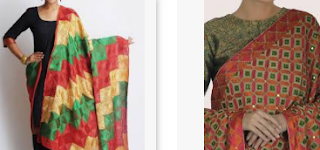Buy Sikh Items From Online Sikh Store
History of Phulkari, which literally translates into 'work of flowers', has a history in the culture of Punjab. This magnificent style of embroidery surrounded by spinning wheel is pattern on odinis, shawals, kurtis and chunris. The main features of flowering embroidery are the use of stitching darn on the wrong side of the fabric with colorful silk thread. Floral is the art of embryo, as well as creation is also called fulcull. Most of the duptas (huge holes) are embroidered with flaky sewing. Although anything from the bag to the cushion cover can bring color brightness with this unique craft. A face of fashion that finds its first mention in the Punjabi folklore of romantic hero Herre and Ranjha, Phulari is a dream weaver for every Punjabi girl.
History
Flowers, flowers are one of the most colorful and vibrant embroidery of India. Practiced in the state of Punjab, it originated in the fifteenth century. Due to the lack of evidence and documentation, its history and origin are individually different. The origin of this beautiful art can be seen back in the 15th century AD. Some people said that the florist was made in the famous love story of Heer-Ranjha, written by Waris Shah (1725-1799), in which many dresses are included in floral articles, it is clear that Fulkari is an article main In the form of the girl has been presented during her marriage Some people have thought that this craft has been shifted from Persian art, where there is a very similar literal meaning from 'Gulkari', 'Gul' means 'flower' and 'curry' means to look like a fool, a And the principle that resembles the flowerman looks like.
Another theory which reveals that the Jat tribe of East Punjab, originally migrated from Central Asia, is the forerunner of this craft, this was my strongest theory for which I came during my research, this Jat is also the other of India In these states, these crafts have been taken, like Haryana, Rajasthan and Gujarat.
There were rumors in many ancient artifacts of Phulkari, by the sister of Guru Nanak Dev ji, Sikh guru, there was somewhere in the fifteenth century. At the end of the 15th century, Guru Nanak, founder of Sikhism, wrote: "You are not a meaningful woman till you have embroidered your own blouse". The women of the village still practice crafts, bedding and cushion covers and many other clothes also sew, but art probably reached its peak in the late 19th and early 20th centuries.
Design and Pattern
There is a broad pattern of designs used in the flowerery. There is expression in every possible representation of life and nature. Although it began with geometric patterns, flowers and leaves, today, designs have been extended to include birds, animals, human figures, objects of sun, moon, everyday objects and everything found on earth. Then, there is a special bag design called Duph-Chhon (Sun Shadow), which is very popular in the state. However, no religious themes or courtesan scenes are not embroidered. Some of the most famous varieties of flowers and orchards have been listed below.
1. Chop: During a ceremony before marriage, this kind is usually presented to the bride by her grandmother. It has a straight, two-sided line sewing and it appears on the opposite. However, only the border is done and the center is left plain. It is usually red in color and worn as a curtain.
2. Ver-da-garden: This is done on red clothes too. This lotzange is covered with golden yellow embroidery, in which there are small people within the limit.
3. Darshan Gate: Usually used for the presentation in the temples or for decorating the walls of the house, when the Granth Sahib is brought in it. It is also done on a red cloth, in which there are shapes of tanning doors facing the design of humans, animals, birds, flowers etc.
4. Chamba: It contains a series of steam cleansers, stylized leaves and flowers and is popular in recent times.
5. Ghaghghat Bagh or Sari-Pallau: Usually the pallu and the part which covers the head. Pullu is a triangular embroidery part in the part of the head and the remaining fabric is only embroidered on borders.
6. Bavan Bagh: Twine means fifty two, it is a style in which there are various geometrical designs which are embroidered on a piece of cloth.
7. Subar: Subar is a piece of cloth which is worn by the bride in marriage while spreading around the Guru Granth Sahib or holy fire. In the cloth, five forms are made in four in the center and four four embroidery on four corners.
8. Satanganga: A seven-colored blossom.
9. Thirama: The special characteristic of Thirima is its white clay that symbolizes purity. Due to its white color, it was often worn by elderly women and widows. The thread used for the embroidery ranges from red to pink.
10. Sai Phulkari: The village life of Punjab was depicted in Sanchi Phulkari and this style was confined to very few areas of Punjab, such as Firozpur and Bathinda districts.
For More info:-->

No comments:
Post a Comment